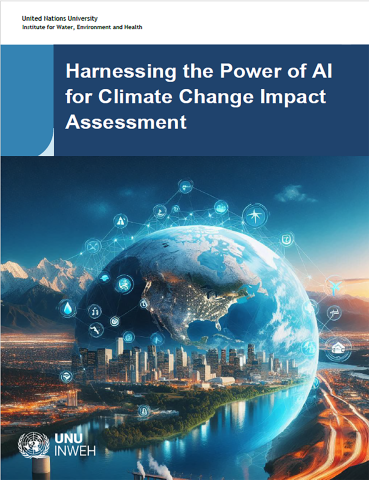Obringer, R., Kumar, R. and Madani, K. (2024). Harnessing the Power of AI for Climate Change Impact Assessment, United Nations University Institute for Water, Environment and Health (UNU-INWEH), Richmond Hill, Ontario, Canada, ISBN: 978-92-808-6120-4 , DOI: 10.53328/INR24ROR012
Download the report

Climate change impact assessment is critical for creating adequate climate change mitigation and adaptation policies and plans. Critical infrastructure systems (e.g., water and energy systems) are particularly at risk for climate change impacts. In fact, a better understanding of climate change impacts on the water and energy systems would facilitate the fulfillment of SDG2 (end hunger), SDG 6 (clean water and sanitation), SDG 7 (affordable and clean energy), SDG 11 (sustainable cities and communities), and SDG 13 (climate action), with many indirect benefits across many other areas. Nonetheless, conducting climate change impact assessment, particularly at the community-level, is not an easy task. Often, the impact assessment models require access to substantial computational resources to run the complex models, as well as the expertise to work with those models and interpret their results, which may not be possible for all communities. As such, there is a need to expand climate change impact assessment to include more accessible models that can handle high-resolution, local data that is of interest to communities. Here, we highlight how climate impact assessment studies can benefit from the power of artificial intelligence (AI). The report details the use of AI model to conduct a computationally efficient climate change impact assessment. This model is applied to a case study across the United States of America (U.S.) as an example to showcase the insights it generates in real-world applications. To demonstrate this process, the study will focus on the impacts on coupled water and electricity demand (e.g., the water-electricity demand nexus). To conduct the impact assessment, the report demonstrates two different means of collecting future climate data—Coupled Model Intercomparison Project 5 (CMIP5) Earth System Models (ESMs) and contemporary climate analogs. Our results show significant increases across the Midwestern U.S. when using ESM-derived data. Similar results were found through the climate analog-derived data, suggesting that the analogs can be used successfully as proxies for traditional ESM data in communities that might not have access to the larger CMIP suite of models. Understanding the impacts of climate change on critical infrastructure is important for building sustainable and equitable policies for climate change mitigation and adaptation. These infrastructure systems are often interconnected (e.g., the water-energy nexus) and managed by local entities. Thus, while climate change is a global problem requiring cooperation across countries and sectors, many solutions require local action. In this sense, the results presented here can be used to deepen our scientific understanding of climate change impacts on the water-energy nexus, as well as develop novel methodologies that integrate AI with traditional climate change impact assessment to better prepare local communities for the future.
Read the press release here
Photo credit (cover page): Images were generated by Generative Artificial Intelligence.
Suggested citation: "Harnessing the Power of AI for Climate Change Impact Assessment," United Nations University, UNU-INWEH, 2024-08-27, https://unu.edu/inweh/article/harnessing-power-ai-climate-change-impact-assessment.




